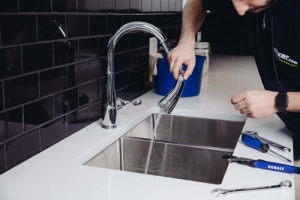The author is making a number of great points relating to Leaky Faucets: Why They Happen & What to Do About Them overall in the article further down.

Dripping faucets might appear like a small inconvenience, however their impact exceeds simply the annoyance of the sound. From wasting water to sustaining unneeded economic costs and health and wellness threats, disregarding a trickling tap can bring about different effects. In this short article, we'll look into why it's critical to address this usual family problem without delay and effectively.
Wastage of Water
Environmental Effect
Trickling faucets add significantly to water wastage. According to the Epa (EPA), a solitary tap leaking at one drip per second can lose greater than 3,000 gallons of water annually. This not just stress water sources however likewise impacts environments and wild animals dependent on them.
Step-by-Step Overview to Taking Care Of a Dripping Tap
Tools Needed
Prior to trying to fix a dripping faucet, gather the essential devices, consisting of a flexible wrench, screwdrivers, replacement parts (such as washing machines or cartridges), and plumber's tape.
Usual Tap Issues and Their Solutions
Recognize the kind of faucet and the particular concern triggering the drip. Common problems consist of worn-out washers, rusty valve seats, or defective O-rings. Describe maker directions or online tutorials for detailed support on repair services.
Financial Expenses
Enhanced Water Costs
Past the environmental influence, leaking faucets can pump up water bills considerably. The collected waste over time converts into greater utility expenses, which might have been avoided with prompt repair work.
Potential Home Damage
In addition, extended trickling can result in harm to fixtures and surface areas surrounding the faucet. Water buildup can trigger discoloration, corrosion, and also architectural issues if left neglected, resulting in added repair expenses.
Health Worries
Mold and Mildew Development
The constant existence of dampness from a dripping tap creates an excellent setting for mold and mildew growth. These fungis not only compromise interior air top quality but likewise posture health risks, specifically for individuals with respiratory conditions or allergic reactions.
Waterborne Diseases
Stagnant water in trickling taps can come to be a breeding ground for bacteria and other pathogens, raising the risk of waterborne illness. Pollutants such as Legionella microorganisms thrive in stagnant water, possibly leading to major diseases when ingested or breathed in.
DIY vs. Specialist Repair service
Advantages and disadvantages of Do It Yourself Repair Service
While some might attempt to take care of a trickling faucet themselves, do it yourself repair work feature their own set of difficulties. Without correct knowledge and devices, do it yourself efforts can intensify the problem or lead to insufficient repair work, extending the problem.
Advantages of Working With an Expert Plumber
Employing an expert plumber guarantees that the underlying reason for the trickling faucet is attended to properly. Plumbing professionals possess the knowledge and equipment to detect and fix faucet concerns efficiently, saving time and lessening the threat of additional damages.
Ecological Duty
Specific Contribution to Preservation
Taking responsibility for dealing with dripping faucets lines up with more comprehensive initiatives toward water preservation and ecological sustainability. Every person's activities jointly make a significant influence on maintaining priceless sources.
Lasting Living Practices
By focusing on prompt repair work and taking on water-saving habits, people add to sustainable living techniques that profit both existing and future generations.
Preventive Measures
Normal Maintenance Tips
To avoid leaking faucets, carry out routine upkeep such as cleaning aerators, examining for leakages, and replacing damaged components promptly. In addition, take into consideration setting up water-saving tools or updating to extra effective components.
Relevance of Prompt Repairs
Addressing leaking faucets as quickly as they're discovered protects against further water wastage and prospective damage, eventually conserving both water and money over time.
Impact on Residential Or Commercial Property Value
Understanding of Well-Maintained Home
Keeping a property in good condition, consisting of addressing maintenance concerns like trickling faucets, improves its viewed value and value amongst possible buyers or renters.
Influence on Resale Worth
Properties with well-kept plumbing components, consisting of faucets, command higher resale worths in the real estate market. Dealing with leaking faucets can add to a favorable impact during home inspections and arrangements.
Final thought
Addressing a leaking tap surpasses mere ease; it's an important step toward saving water, minimizing economic prices, and securing wellness and property. Whether through DIY repairs or expert help, acting to repair dripping faucets is a tiny yet impactful means to promote liable stewardship of sources and contribute to a healthier, a lot more sustainable future.
How to Fix a Leaky Faucet: Step-by-Step Repair Guide
A leaky faucet may seem like a simple annoyance, but if it's not fixed promptly, that leak could cost hundreds to potentially thousands. From water damage to mold, mildew, and high water bills, even a tiny leak can be catastrophic if left unattended. Damage like this can even affect the overall value of your home, so it's important to take the right approach for leaky faucet repair. You may need the help of a plumber in some cases, but we've got a few tips you can try on how to fix a leaky faucet before calling the pros.
Four Faucet Types
When you're learning how to fix a leaky faucet, the first step is knowing what kind of faucet you're working with! There are four common types.
Cartridge Faucets
Cartridge faucets come in one- or two-handled varieties. In one-handled cartridge faucets, hot and cold water combines in a single cartridge. In the two-handled versions, hot and cold water are controlled separately and mixed in the faucet.
Ball Faucets
Ball faucets have a single lever you push up and down to adjust the pressure and rotate to change the temperature. A slotted metal ball controls the amount of water allowed into the spout.
Compression Washer Faucets
They're the oldest type of faucet, but they're still used in many homes — especially older ones. Compression faucets have two separate handles that, when turned, raise or lower the washer that seals a water valve. This valve stops water from flowing through the faucet when it is turned off.
Disc Faucets
Disc faucets rarely need to be repaired due to their maintenance-free design. The water flow is controlled by two discs — the upper one raises and lowers against a fixed lower disc, creating a watertight seal. If your disc faucet starts leaking, you may need to replace the seals or clean residue buildup from the inlets.
Fixing a Leaky Faucet
Step 1: Turn Off the Water
Whether you're learning how to fix a leaky bathtub faucet or how to fix a leaky kitchen faucet, always turn off the water supply to your working area when you're fixing a leak. The last thing you want is a flood added to your list of things to fix.
Look for the shutoff valves below your sink or around the tub and turn them clockwise to stop the water flow. If your faucet doesn't have shutoff valves, you may need to turn off the water for the whole house. Check to make sure it's off by turning the faucet on. If nothing comes out, you're ready to start the repair.
Step 2: Take Apart the Faucet
How you disassemble your faucet depends on the type of fixture you have. You can use a flathead screwdriver to remove the caps on top of the handle or handles for cartridge and compression faucets. Inside, you should see handle screws. Unscrew these with a screwdriver to remove the handle.
Disc- and ball-style faucets will typically have an inlet screw near the handle, and removing that will reveal the interior of the faucet.
Detach the Valve Stem
For cartridge- and compression-style faucets, you'll see the inner valve stem or cartridge once you remove the faucet handles. If you have a compression faucet, unscrew the brass valve stem. If you have a cartridge faucet, pull out the cartridge. If your cartridge has been in place for a while, it may require some tools or extra force to remove it due to mineral deposits.
Examine and Replace Parts
Once you've removed the parts, check them out to confirm what needs to be replaced. You may see corroded rubber washers, O-rings, stems, or cartridges. On a ball-style faucet, check the seats and springs for damage.
If you need to repair a leaky disc faucet, check the inlet and seals on the lower disc.
Once you determine what parts must be replaced, visit your local hardware store. Bring the damaged parts with you to ensure you can purchase the correct components to replace them.
Clean Valves and Faucet Cavity
If you've removed a stem or cartridge, you may notice mineral buildup in the faucet's threads. Use white vinegar to clean the valve seat by soaking it for a few minutes, then scrub it away with a soft toothbrush and rinse with warm water. You can also clean the interior of the faucet in the same way.
Reassemble the Faucet
Once your faucet is cleaned and the required parts have been replaced, it's time to reassemble it. Put the pieces back together and slowly turn the water supply back on. Doing this slowly is crucial because too much initial water pressure can damage the new hardware you've just installed.
https://homewarranty.firstam.com/blog/how-to-fix-leaky-faucet

We are very eager about 4 Common Reasons for a Leaky Faucet and I hope you enjoyed reading the entire blog posting. In case you enjoyed our post if you please do not forget to share it. Kudos for being here. Come back soon.